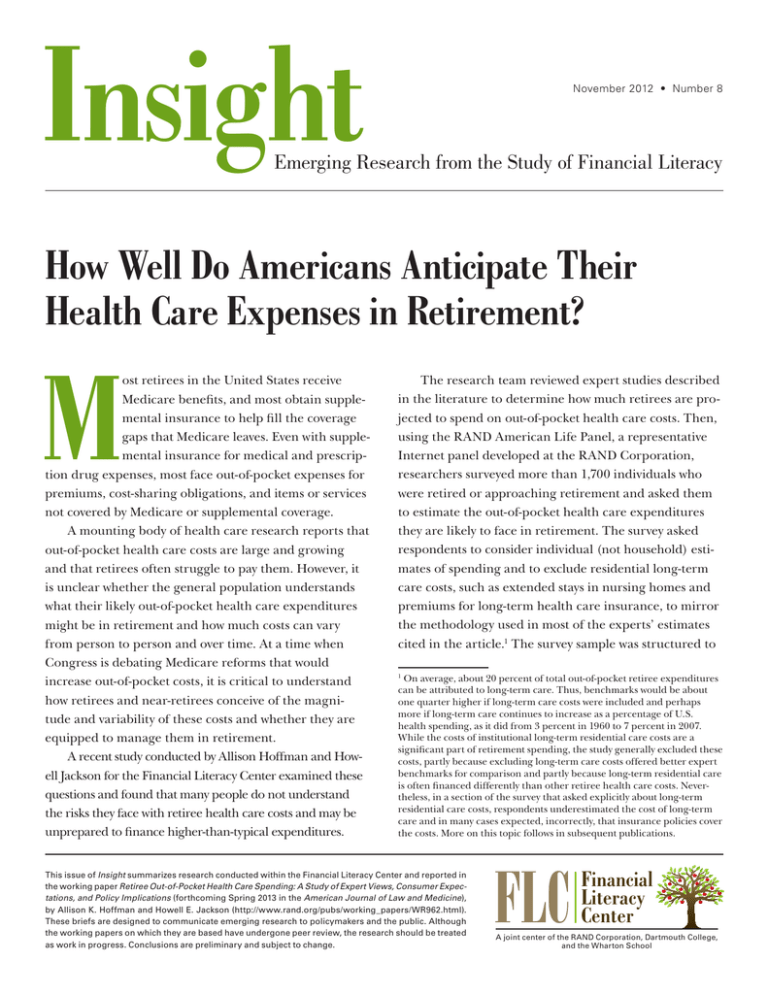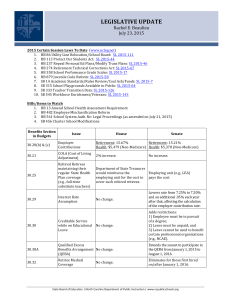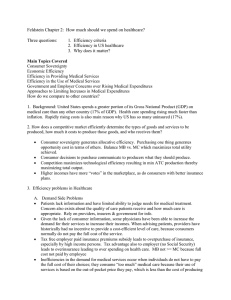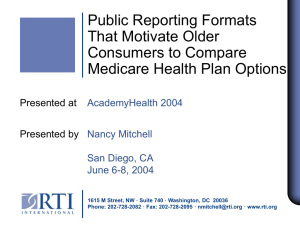Insight M How Well Do Americans Anticipate Their Health Care Expenses in Retirement?
advertisement

Insight November 2012 • Number 8 Emerging Research from the Study of Financial Literacy How Well Do Americans Anticipate Their Health Care Expenses in Retirement? M ost retirees in the United States receive Medicare benefits, and most obtain supplemental insurance to help fill the coverage gaps that Medicare leaves. Even with supplemental insurance for medical and prescription drug expenses, most face out-of-pocket expenses for premiums, cost-sharing obligations, and items or services not covered by Medicare or supplemental coverage. A mounting body of health care research reports that out-of-pocket health care costs are large and growing and that retirees often struggle to pay them. However, it is unclear whether the general population understands what their likely out-of-pocket health care expenditures might be in retirement and how much costs can vary from person to person and over time. At a time when Congress is debating Medicare reforms that would increase out-of-pocket costs, it is critical to understand how retirees and near-retirees conceive of the magnitude and variability of these costs and whether they are equipped to manage them in retirement. A recent study conducted by Allison Hoffman and Howell Jackson for the Financial Literacy Center examined these questions and found that many people do not understand the risks they face with retiree health care costs and may be unprepared to finance higher-than-typical expenditures. The research team reviewed expert studies described in the literature to determine how much retirees are projected to spend on out-of-pocket health care costs. Then, using the RAND American Life Panel, a representative Internet panel developed at the RAND Corporation, researchers surveyed more than 1,700 individuals who were retired or approaching retirement and asked them to estimate the out-of-pocket health care expenditures they are likely to face in retirement. The survey asked respondents to consider individual (not household) estimates of spending and to exclude residential long-term care costs, such as extended stays in nursing homes and premiums for long-term health care insurance, to mirror the methodology used in most of the experts’ estimates cited in the article.1 The survey sample was structured to On average, about 20 percent of total out-of-pocket retiree expenditures can be attributed to long-term care. Thus, benchmarks would be about one quarter higher if long-term care costs were included and perhaps more if long-term care continues to increase as a percentage of U.S. health spending, as it did from 3 percent in 1960 to 7 percent in 2007. While the costs of institutional long-term residential care costs are a significant part of retirement spending, the study generally excluded these costs, partly because excluding long-term care costs offered better expert benchmarks for comparison and partly because long-term residential care is often financed differently than other retiree health care costs. Nevertheless, in a section of the survey that asked explicitly about long-term residential care costs, respondents underestimated the cost of long-term care and in many cases expected, incorrectly, that insurance policies cover the costs. More on this topic follows in subsequent publications. 1 This issue of Insight summarizes research conducted within the Financial Literacy Center and reported in the working paper Retiree Out-of-Pocket Health Care Spending: A Study of Expert Views, Consumer Expectations, and Policy Implications (forthcoming Spring 2013 in the American Journal of Law and Medicine), by Allison K. Hoffman and Howell E. Jackson (http://www.rand.org/pubs/working_papers/WR962.html). These briefs are designed to communicate emerging research to policymakers and the public. Although the working papers on which they are based have undergone peer review, the research should be treated as work in progress. Conclusions are preliminary and subject to change. FLC Financial Literacy Center A joint center of the RAND Corporation, Dartmouth College, and the Wharton School F i n a n c i a l LI t e r a c y consist of respondents in eight groups based on age. In the youngest group, respondents were 40–44 years old; in the oldest group, they were 75–80 years old. Finally, the research team compared the respondents’ estimates of future spending with the experts’ estimates of future costs, focusing on areas where the respondents’ estimates strayed furthest from those of the experts. What Do the Experts Say About Future Costs? A retiree’s out-of-pocket health care expenses include insurance premiums for Medicare and any supplemental insurance; co-payments and deductibles; and health care that is not covered by insurance, such as dental care and expenses that exceed policy limits. In developing benchmarks for the study, it quickly became clear that there is no definitive estimate of what these costs might be in the future. The designs of leading studies vary in several ways, producing inconsistency in estimates. First, because many different sources finance health care for retirees, there is no one database that accurately captures all health care spending, and researchers disagree on which survey data are most accurate. Second, studies are inconsistent in what they include as out-of-pocket costs. And third, estimating future health care costs is an uncertain science because of the unpredictable nature of medical cost inflation and the future policy environment. Despite these challenges, the researchers were able to estimate a range of monthly, annual, and lifetime health care costs based on leading studies. Based on these ranges, the researchers developed distributions of predicted health care costs for 2010, 2020, 2030, and 2040. The researchers then compared the distribution of survey responses with the distribution of costs that experts predict for current and future retirees. Table 1 shows the median and 75th percentile projected estimates of annual and monthly out-of-pocket health care expenses for 2010, 2020, 2030, and 2040 that the researchers used. According to these estimates, the typical retiree spent in excess of $200 per month on health care costs in 2010 and will spend in excess of $500 per month by 2040. The share of adults who spend more than one-fifth of household income on health care is 2 h t t p: // f inancial - li teracy.rand.org C e n t e r estimated to grow to 45 percent in 2040, from 18 percent in 2010 (not shown in the table). A second way to gauge respondents’ understanding of their future health care expenses is based on their ability to estimate lifetime spending (see Table 2). According to a leading study, median lifetime retiree health care costs are estimated at $109,000 for a man and $156,000 for a woman who retires in 2020; the estimate at the 75th percentile of spending is $198,000 for a man and $230,000 for a woman. For someone who retires further in the future, the estimates are considerably higher, even when measured in terms of constant dollars. Researchers also explored respondents’ understanding of the sources and magnitude of variability and uncertainty in the estimates, with particular attention to three major factors: Table 1. Estimates of Retirees’ Monthly Out-of-Pocket Health Care Expenditures Year Median Annual Estimate (Monthly) 75th Percentile Annual Estimate (Monthly) 2010 $2,583 ($215) $3,934 ($330) 2020 $3,284 ($274) $4,959 ($413) 2030 $4,569 ($381) $6,855 ($571) 2040 $6,214 ($518) $9,455 ($788) Source: Richard W. Johnson and Corina Mommaerts, Will Health Care Costs Bankrupt Aging Boomers? The Urban Institute, 2010. Notes: Values are in constant 2010 dollars. Excludes long-term care spending. Uses Medicare Board of Trustees’ 2009 intermediate growth rate of 2.8 percent. Estimates generated using Urban Institute DYNASIM3 micro simulation model and rounded to nearest dollar. Table 2. Estimates of Retirees’ Lifetime Out-of-Pocket Health Care Costs Man retiring in 2010 Median Lifetime Estimate 75th Percentile Lifetime Estimate $65,000 $118,000 Woman retiring in 2010 $93,000 $137,000 Man retiring in 2020 $109,000 $198,000 Woman retiring in 2020 $156,000 $230,000 Source: Paul Fronstin, Dallas Salisbury, and Jack VanDerhei, Funding Savings Needed for Health Expenses for Persons Eligible for Medicare, Employee Benefit Research Institute, Issue Brief No. 31, December 2010. Notes: Values are in constant 2010 dollars. Uses Medicare Board of Trustees’ 2011 intermediate growth rate. Based on an individual with wraparound Medicare (Medicare Parts A, B, D, and Medigap Plan F). F i n a n c i a l LI t e r a c y C e n t e r 1. Uneven distribution of costs among retirees. It is impossible to predict with confidence how costs will be distributed among individuals in any year or over the course of their retirement. The distribution of costs is notoriously uneven. Studies estimate annual spending ranges from $1,909 annually for those in the 25th percentile to over $20,000 at the 99th percentile. However, some factors have predictive value: • Gender. Women spend as much as 40 percent more than men, excluding long-term care, partly because they tend to live longer. • Wealth or income. Higher income or wealth can more than double expenditures, suggesting that to some extent retiree health care spending is discretionary. • Health status. Even though annual expenditures are more for those in poor health, they live shorter lives and typically have lower total lifetime expenditures. According to one study, the healthy spend approximately 20 percent more over a lifetime. • Type of supplemental insurance coverage. Variability in total spending based on type of supplemental coverage could be driven by higher premiums or cost-sharing for a particular type of coverage or the fact that retirees with certain forms of supplemental insurance use more care than others. 2. Unanticipated health care cost growth. It is extremely difficult to predict the rate of health care cost growth and whether it will continue to rise at a faster rate than inflation. If health care costs were to grow at GDP plus 2 percent instead of the usual GDP plus 1 percent in retirement, the out-of-pocket costs of average retirees would increase about 10 percent over their lifetimes, with an additional increase of approximately 10 percent for every additional percentage point by which out-of-pocket costs exceed GDP growth. 3. Changes in Medicare. Policy changes, especially those made to the Medicare program, will shape future retiree costs in significant and unpredictable ways. Some leading reform proposals, including that in Representative Paul Ryan’s “Path to Prosperity” FY2013 budget plan that the House of Representatives passed in March of 2012, attempt to curb future federal budget spending on health care by converting Medicare from a defined benefit to a defined contribution program. h t t p: // f inancial - li teracy.rand.org 3 With this plan, Medicare beneficiaries would pay an increasing share of total costs as Medicare pays less, with a typical retiree’s share of health care costs as much as doubling by 2022, according to an estimate by the Congressional Budget Office of the effects of a 2011 version of Ryan’s proposal. The durability of current policies that limit retiree out-of-pocket spending will also greatly affect future exposure. The Patient Protection and Affordable Care Act and the Health Care and Education Reconciliation Act of 2010 will alter retirees’ exposure in some predictable ways, such as reducing out-of-pocket expenditures on prescription drugs. Other provisions of these laws will have less predictable effects. Survey Results In the survey, the researchers asked all respondents to estimate health care expenditures in two different ways: • What did they anticipate their average monthly out-ofpocket costs to be in retirement? • What lump sum would they need to accumulate by the age of 65 to pay for their expected total out-of-pocket costs for health care in retirement? Overall, Many Respondents’ Expectations of Future Out-of-Pocket Costs Are Sensible; but About Half of Respondents Made Total Spending Estimates Substantially Beneath Expert Projections of Typical Health Care Expenditures Many of those surveyed seem to understand their likely future health care spending needs. Respondents estimated certain determinants of health care costs, including likely future insurance coverage, premiums, and life expectancy, at levels surprisingly close to what experts predict. Many also estimated total out-of-pocket expenditures at or above the levels that experts predict for typical retirees. These results suggest that lack of understanding of future health care expenses, in itself, does not explain financial planning shortcomings. However, an even larger group—nearly half of all respondents—underestimated future health care costs. For example, their estimates of out-of-pocket health care F i n a n c i a l LI t e r a c y C e n t e r expenses were considerably below what experts predict for typical retirees. Women and Young Respondents Were Most Likely to Underestimate Women were significantly worse predictors of typical future spending than men. Women are generally expected to incur greater retiree health care costs than men, largely as a result of their longer life expectancies. As a result, a typical woman might be expected to have out-of-pocket health care costs in retirement 40 percent higher than a typical man’s. But women generally estimated lower average monthly costs than men, with a median monthly estimate of $190 for women as compared with $217 for men. This difference was even more pronounced for lifetime estimates: Women’s median estimate was $30,000, versus $60,000 for men. The estimates of future health care expenditures made by middle-aged respondents (40–60-year-olds) were nearly identical to the estimates made by older respondents, despite the fact that the younger group’s actual costs will be significantly higher by the time they retire, due to health care cost growth. This insight suggests that the problem of savings insufficiency might worsen over time, considering that 40–60-year-olds misperceive the amount they should be saving for future expenditures. Respondents Did Not Accurately Assess Their Potential Risk for Higher Costs Much of the possible variability in spending—either among retirees or over time—is not predictable based on any demographic factors. The researchers examined perceptions with regard to the three main sources that make it difficult for an individual to know future expenditures: variation in their own health, unanticipated medical cost growth, and changes in government policies. Most respondents identified all of these sources as causing concern, but they didn’t appreciate the magnitude of possible risk they could face from each. In particular, respondents in all age groups underestimated the risk of variation in personal health expenditures. While arguably the greatest of the three sources of risk for anyone nearing or in retirement, respondents did not identify it as a greater risk than the others and h t t p: // f inancial - li teracy.rand.org 4 underestimated the magnitude of variability in spending they might face if they were in the upper end of the distribution. They also underestimated the magnitude of potential risk from policy change, especially at a moment in time when Medicare is vulnerable to fundamental changes. These findings suggest that many people do not appreciate the risks they face with retiree health care costs and may be unprepared to finance higher-thantypical expenditures. Policy Recommendations This study produced several suggestions for health care policy and financial education. As a preliminary point, the researchers highlighted the need for better collection of data on out-of-pocket health care costs and greater consistency in how these costs are defined and measured. As health care costs continue to increase—both for the government and for individuals—policymakers will be acutely focused on this problem. The lack of consistent, quality data makes it difficult to address a health care spending problem when there is disagreement on the definition of and magnitude of the spending among the experts in this field. And, of course, consumers can hardly be expected to make informed choices if the underlying data are inaccessible or incomprehensible. Design Policies That Help Consumers Understand the Variability of Out-of-Pocket Costs or That Lessen the Range of Variability The variability in out-of-pocket costs—and the difficulty of understanding that variability—creates a substantial public policy problem. Studies show that individuals chronically struggle to understand risk, suggesting that the problem identified in this study runs deeper than confusion with the structure of health care financing. Two different approaches might warrant further consideration. • Increase the transparency of insurance policies so that consumers can understand their risks and potential gaps in coverage, and promote the uptake of low-risk policies. Currently, insurance regulation requires disclosure of certain information, such as deductibles, co-pays, and annual and lifetime limits, F i n a n c i a l LI t e r a c y C e n t e r but does not make transparent residual payment risk that falls to policy holders. What purchasers of these policies should really be informed about is the distribution of out-of-pocket costs under various insurance options. For example, all supplemental Medigap policies could provide a graph that illustrates the out-of-pocket spending distribution among all enrollees in a particular plan. The buyer could compare his out-of-pocket exposure at the 25th, 50th, 75th, and 90th percentiles of one plan against his exposure at the same levels of spending in another. An important role for government would be to require the collection of these data and the promotion of their dissemination in addition to guidance as to how to interpret the data. Regulators might also promote consumer choice of policies that better protect them against spending risk. • Limit out-of-pocket exposure. While Medicaid provides a safety net for the poorest retirees, near-poor and middle-class retirees face considerable risk of significant threats to standards of living in retirement and an unexpected dissipation of financial assets, even if they have Medicare and supplemental coverage. If supplemental coverage was more focused on insuring that lifetime out-of-pocket costs did not exceed some number (like $100,000), even perhaps trading off some higher deductibles for more routine costs, it might better protect against serious financial crisis in the long run. To protect lower-income individuals against unmanageable risk, the government could provide additional subsidies to buy better supplemental coverage or could make efforts to increase enrollment in the subsidy programs already in place. 5 h t t p: // f inancial - li teracy.rand.org Be Cautious About Policy Reforms That Shift Costs to Retirees This study advises policymakers to carefully consider the implications of Medicare reforms that would increase outof-pocket spending risk. In particular, the study suggests that health policy reforms that would shift out-of-pocket costs to retirees who struggle to anticipate and manage these additional costs are likely to increase retirees’ financial hardships in old age. Offer Financial Education on Specific Topics and to Specific Subgroups The researchers’ findings reveal some areas in which well-targeted educational efforts, tested for effectiveness with the intended audience, might bring expectations more in line with expert estimations. The introduction of readable, plain-language materials describing the magnitude of expenditures and factors that could drive higher expenditures would be a significant step, considering the current void of such resources. The findings suggest a need to focus on • Women. Closing the literacy gender gap with regard to retiree health care expenditures is critical, in light of the fact that women live longer than men and will need to manage out-of-pocket spending for more years and, for those who outlive a spouse or partner, on their own. • 40–60-year-olds. This age group, which does not do well at anticipating growth in health care costs in retirement, needs special attention. Because they are still in their earning years, they are in the best position to save for future expenditures. ● The Financial Literacy Center is a joint center of the RAND Corporation, Dartmouth College, and the Wharton School of the University of Pennsylvania. Established in 2009 with support from the Social Security Administration, its mission is to develop and test innovative programs to improve financial literacy and promote informed financial decisionmaking. http://financial-literacy.rand.org WB-116 (2012)




